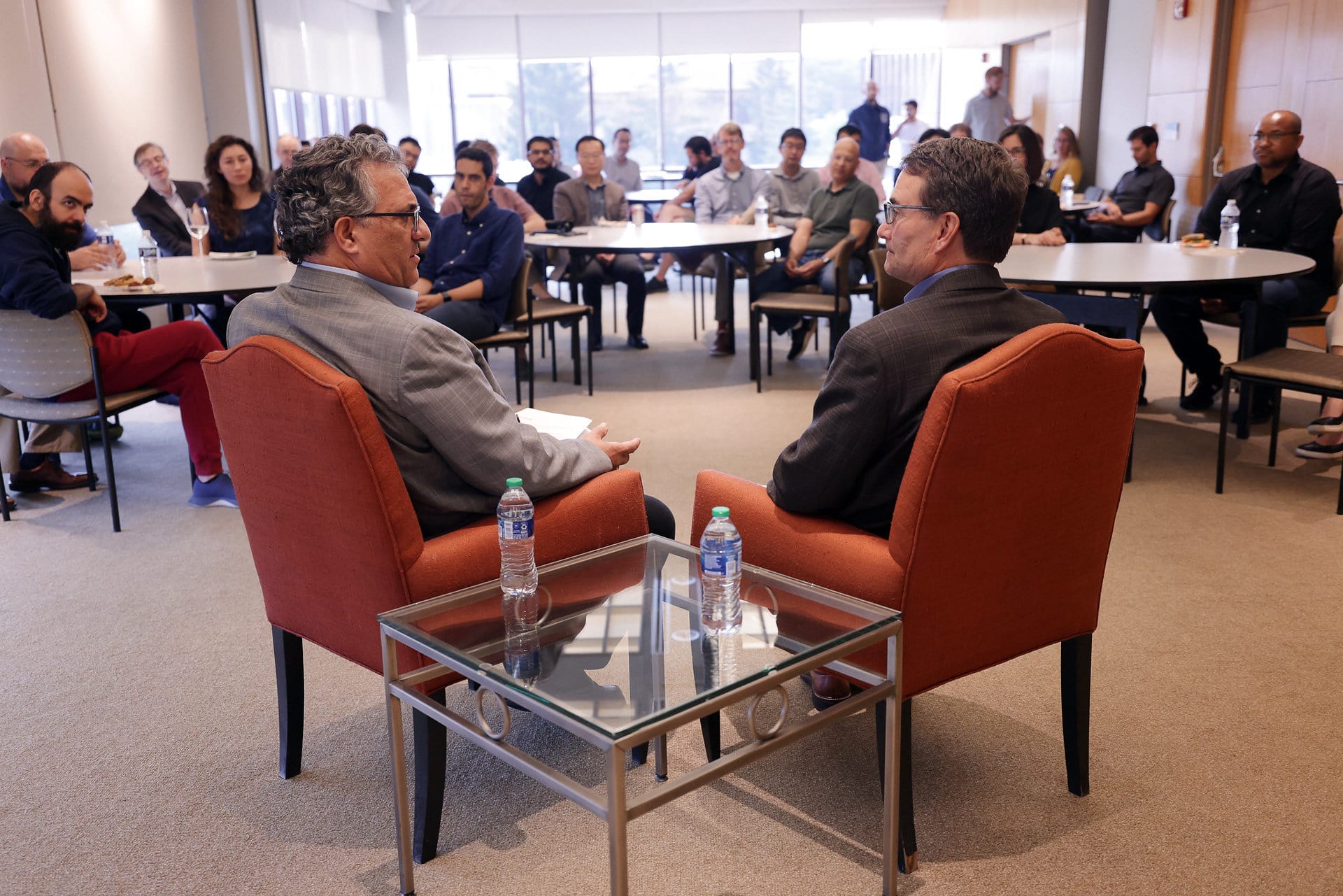
Toyota Research Institute and Michigan Engineering discuss importance of long-standing partnership
As the auto industry expands beyond transportation, university collaborations are more important than ever.

As the auto industry expands beyond transportation, university collaborations are more important than ever.
In a recent fireside chat, leaders from the Toyota Research Institute (TRI) and Michigan Engineering discussed research priorities, industry shifts and the value of deep collaboration.
The University of Michigan, one of 16 TRI university partners, is one of its longest standing collaborators, along with MIT and Stanford. Since TRI’s founding in 2016, the institute has funded $37 million in projects at Michigan Engineering, leading to 130 papers, 39 patent applications and numerous U-M hires at TRI.
The fireside chat occurred during a campus visit from Eric Krotkov, advisor to TRI’s University Research Program and former TRI chief science officer. Krotkov was interviewed by Steve Ceccio, Michigan Engineering interim dean.
Following is an edited transcript.
Steve Ceccio: I just want to say, on behalf of my colleagues in the College, that Toyota is really a foundational relationship for us at all levels. Thank you for your continuing and steadfast support, and for giving us the opportunity to ask you a few questions.
Ceccio: We cannot have a fireside chat without talking about generative AI. It’s just now part of the gig. What do you think are some of the possibilities around mobility and these new technologies like AI?
Eric Krotkov: Not just at Toyota Research Institute, but across the whole automotive industry, there are four big opportunities now collectively known as CASE: Connectivity, Autonomy or Assistance, Shared and Electric.
Connectivity makes it so that the driver is not just the operator of the car, but sort of the center of the universe. They can be a shopper, a traveler, an explorer, and run a business all from the car. The opportunities in e-commerce and blockchain are just staggering. Autonomy, the self-driving, is another gigantic opportunity. The big savings or payoff for that, I think, is safety. I think that’s going to save many lives. Another huge opportunity is rideshare. That’s kind of a conundrum for the original equipment manufacturers, the OEMs, because it means that there’s a need for fewer cars. And electrification—it’s another huge opportunity to reduce carbon emissions and to address some of the problems with rare earth elements that need to go into the magnets that go into the drivetrains and the chemicals that go into the batteries of an electric car.
And so generative AI, I think, could be used in any one of those. That has a lot of opportunity. But to me, I see so many red flags. I’ve written one book. I asked GPT: “Tell me about the books that Eric Krotkov has written.” It said that he wrote three books. One was real and the two were plausible. Yes, I’ve done research in those areas, but there was no book and there was nothing by that title. But it was so convincing. I think that one of the biggest challenges that our community faces is in the responsible use of generative A.I.
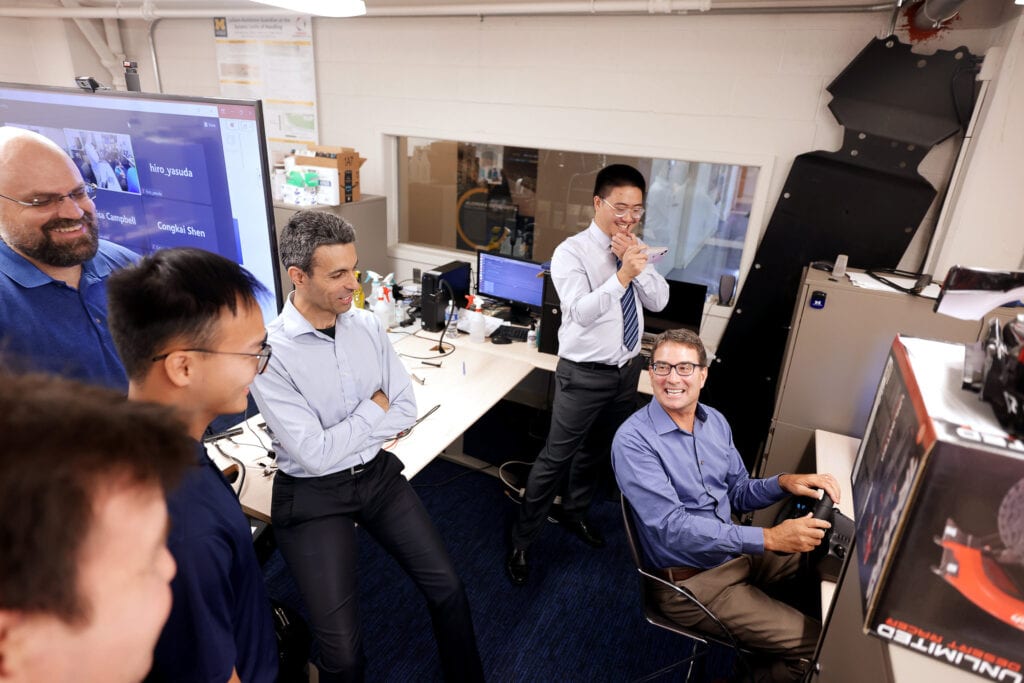
Ceccio: Some folks in the industry talk about becoming a mobility industry as opposed to a car and truck manufacturer. I know Toyota’s also had visions about serving through robotics and other parts of the human experience. Can you comment on Toyota’s future outlook?
Krotkov: Yes, the past president of Toyota Motor Company—our grandparent—is Akio Toyoda, and he was famously talking about the need for Toyota to stop being a car company and start being a mobility company and, you know, addressing all of the CASE opportunities and embracing them. It’s not just cars or trucks, but the whole mobility experience. I believe that most of the other companies are also embracing that.
And it’s a fairly fundamental change. Instead of thinking, “There’s our market, we want to meet these manufacturing or sales quotas. Get to work,” it’s more like, well, “What does our society really need?” Those quotas came from a model of New York City or whatever city that no longer exists. They’re becoming smart cities and are interconnected and thinking about how remote work ties into all of this. So there’s virtual mobility as well as the physical, creating major shifts at Toyota and in the automotive industry in terms of thinking much bigger than just cars and trucks.
Ceccio: That resonates with us here. I think maybe you’ve seen our people-first engineering approach. That sounds like a people-first vision.
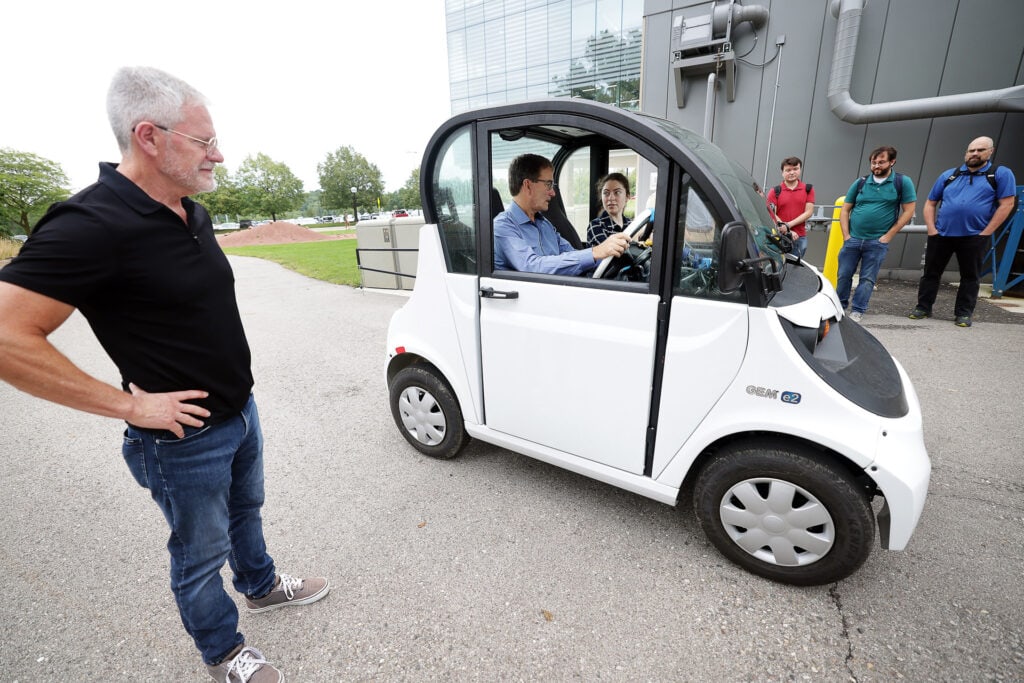
Ceccio: Many of us have interacted with industry. We have contracts and we do our work and sometimes it’s transactional, but TRI’s relationship with the partner universities is anything but that. It’s actually really a deep relationship between your organization and Michigan and the faculty, of course, who work in it. Can you talk a little bit about what motivates you to set up this relationship this particular way?
Krotkov: It’s a great question, and I think it is something that differentiates Toyota and Toyota Research Institute from many of its peers. Toyota has exceptional loyalty to its employees, its customers and the broader society. I have been truly shocked by working for the fifth-biggest company in the world, how sincere they are at the very highest levels about addressing social problems and trying to do what’s right instead of what’s profitable. And they’re able to do both.
The relationship is critical. The way we have seen university partnerships go before is, “Ok, everybody, we’re interested in problem X and its sub-problems. Send in your proposal. We like this one. Here’s a check. Get busy. Do what you said in your proposal and send us the final report.” That just hasn’t been that effective.
So we have a very different model. We have a TRI co-investigator. One of your fabulous alumni here in the audience is an example of one. There is no university partnership project that does not have a TRI co-investigator—somebody who is passionate. If there’s nobody on the team at TRI who’s got that passion, we’re not going to do the project. They then embed themselves with the team. They go to the biweekly lab meetings and it’s their reputation inside of TRI and it’s their name on the papers. It’s their name on the patents. It’s not a transaction, it’s their career.
That kind of relationship creates the spark that gets everyone excited. We want to put in the extra effort to make the project succeed.
Ceccio: It’s a relationship, not a transaction. And to that point, I think that there’s a sort of a pipeline of both talent and ideas that work its way through these relationships with TRI and up through the company. Can you give us some examples of where there’s been some successes?
Krotkov: Well, let me describe the pipeline and then talk a little bit more about how TRI fits into it or manages it. TRI does applied research. Our outputs are papers, patents and demonstrations showing that something is feasible that might not be so obviously feasible, which gives confidence for later stages. We have our partners at the universities and national labs that do basic research, discovering principles and foundations. TRI doesn’t do that.
What’s next in the pipeline is our venture fund. We’re trying to grow the community of people working on the areas that we care about by funding them. And so there’s a $250 million Frontier Technology fund and a $100 million climate fund. Then the next stage in the pipeline is development. That is taking things that are known to be feasible and the demonstration that you did in applied research, and—you made it work once or twice, now make it work in the snow, in the rain with a cheaper processor and prove it and mature it. And then finally there’s production. That’s the whole pipeline.
TRI’s overall goal is not just to help with cars. In fact, Toyota Motor Company does not need much help from anybody in designing, manufacturing, producing, selling, and maintaining cars. They’re looking to try to help develop ideas for and proofs of concept for new businesses for Toyota. Because with ridesharing—and I’m pretty sure that we’re not going to be building a lot more roads, you know—how many more cars can we really build and sustain on the planet?
So what’s Toyota going to do if it’s going to be selling less cars? We rely on our university partners to help us with the understanding of what is possible. And then once we get the seeds of that, we will mature them a little bit in the TRI labs.
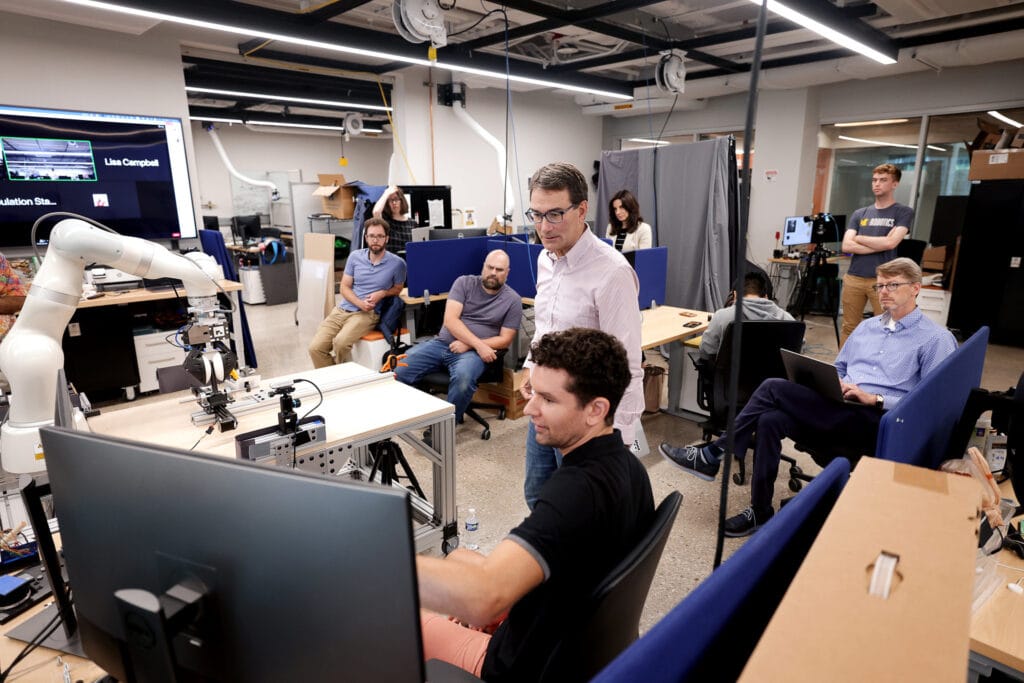
Audience member: I’m an assistant professor of materials science and engineering. I have a few colleagues who have been funded by TRI to do what I would consider very basic, beginning of the pipeline kind of materials discovery questions. And in materials science, we usually think that by identifying a material, there’s still 18 years before maybe it even reaches the market. I was always curious as to why TRI would fund this kind of very fundamental material discovery kind of work, given that it seems quite far away from deployment. And I was wondering if you could comment on that and what kinds of research do you find interesting to fund in the materials space?
Krotkov: Well, Toyota is incredibly patient and has a very long term outlook and it does so well with cars and trucks that it can allocate some of its effort to really long range things. Brian Storey is the head of Energy and Materials Group and his OKRs—objectives and key results—includes things that are due in 2050, which is a goal that Toyota has set for certain emissions standards. And he has a plan. He is targeting the growth of the technology towards that. So yes, TRI is quite different than many other groups.
Hydrogen is one of the fuel sources that no one is talking about. Toyota is almost alone in continuing to fund hydrogen-powered cars. They developed the Mirai. But, you know, there’s no distribution channels for hydrogen except a few trucking places out in California. No matter. There are many patents and intellectual efforts, it really is a long term commitment.
Audience member: I’m a research fellow from the computer science and engineering department. You mentioned vehicles are becoming smarter and smarter. Toyota is branching into more mobility than just vehicles. One thing that we do know for sure is, across these devices, quote-unquote, they’re all getting smarter, right, with the help of AI. But, you know, one of the challenges, obviously, is where the computation should live. Where the on-device computation capability was enough to continue this trend of advancement and how does that interact with and what’s available in the cloud? What are some of the priorities and the focus that TRI has?
Krotkov: Well, that’s a very perceptive, good question. When you go in your automated vehicle and do a data collect, you cannot upload the log file from all the Velodynes, cameras and IMUs. You have to go plug in and it still takes hours to transfer everything. So first of all, TRI is not really active in that anymore. We graduated 150 of our researchers out of research into development. They’re now at Woven by Toyota. They’re the ones doing development of the car. So I think they would answer that we need edge computing. And certainly you can’t do it at all in the cloud. You certainly can’t do it all on board. So we’re going to have to make use of a lot of communications to access computing resources in a city, you know, block by block, and in a rural area cell tower by cell tower. There are also some of these foundation type models, although they’re gigantic. A lot of the executable part can be reduced dramatically in size and fit in a reasonable computer that you’d put in the trunk of your car. And the computation can…a lot of the vision, which I think is the power-hungry and compute-hungry stuff, can be done by specialized processors. So in the long run, I think a lot of it will be done on board, but never all of it. I think that’s a fertile research area.
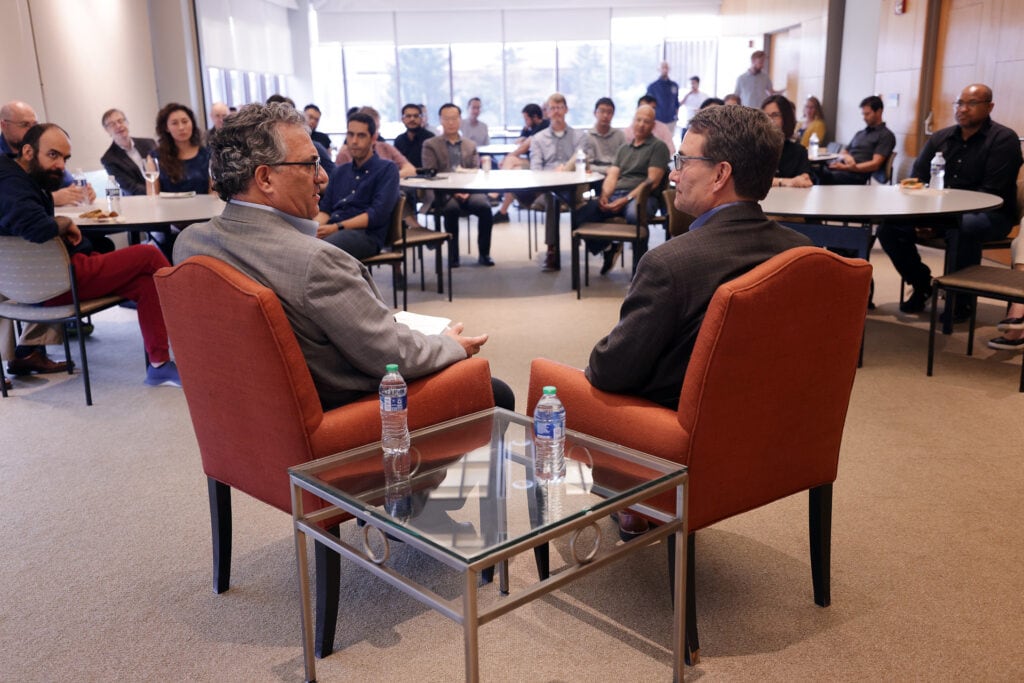
Ceccio: I’ll just add a comment on that. So when I was a youngling and computation was becoming a thing in mechanics, because it was such a constraint on the computational power, a lot of energy went into efficient algorithms, efficient architectures. That’s the only way you could do the problem. And then these young whippersnappers got hold of the really big computers that didn’t really matter how they sort of chop things up. They could get results. I think we’re now entering a period where back to the future, you begin to have to really be more efficient and clever about how you perform your computations.
Krotkov: And do what’s good enough, not what’s perfect.
Audience member: I have another materials question and I feel compelled to extrapolate on some of the statements that you made about long-term vision and the decrease of number of cars on the roads. To what extent is the recycling, or the end of life of the car and its components a concern for Toyota?
Krotkov: Great question. I know there is a new business unit that has sprung up at Toyota Motor North America and recycling and refurbishing the metals and magnets is a big deal. And [the goal is] being able to not have some robotic work cell where you delicately disassemble and say, oh, here are the magnets, but to put them all in a giant bath of some kind, and then as these things evaporate and have it condense in a particular part of the workspace. Doing things in a bulk batch mode I think would be a vision. And I don’t think they have enough technology to do that yet, but I know that they have started a new business unit devoted to that. And can you imagine how many, if you looked at every junkyard in North America, how many batteries you would find? If you could melt them all down and get the nickel or cobalt or other materials out of it and not have to get it from [the Democratic Republic of Congo] or other places, that would be a huge win. There would be a land rush for junkyards all of a sudden. I think it has tremendous potential.
Audience member: I’m in robotics and mechanical engineering and ecology and evolutionary biology. And so given the kind of competition among lots of companies in the robotics and AI areas, I have a question about the priorities of TRI. So would you say that the priorities are sort of in common with what everyone else is working on? Are there any more specific hard problems that TRI is focused on? Or instead are you more interested in surveying the proposals sort of like an incubator for new ideas?
Krotkov: Thank you for that question. The way we pick the kind of research thrusts is pretty top down, and the robotics efforts have been inspired by and pointed at our aging society. This is a huge social trend and problem, and also a big opportunity to make a difference. Japan is feeling this quite acutely now. I think China is not far behind. There are just not enough younger people to take care of the older people. That’s going to be rippling through the West as well soon. So we asked ourselves: What are some of the main ways to address that? And manipulation was the answer. So let’s do a lot of manipulation research.
In energy and materials, there’s lots of great work to do. But if it’s not ultimately reducing carbon, that is the calling. Let’s get our emissions down. That is what is inspiring it all.
Ceccio: I just want to say before we go that a long time ago, this country had something called Bell Labs. And one of the hallmarks of Bell Labs was patience and allowing creativity to flourish and the commitment to the long-term idea of research. It’s nice to know that there are still some institutions who honor those traditions and actualize them. And are partners at Michigan. So once again, I want to thank Eric for his time today and for his partnership.
Krotkov is also president of EK Consulting. Ceccio is also the Vincent T. and Gloria M. Gorguze Professor of Engineering, as well as a professor of naval architecture and marine engineering and mechanical engineering.
Nicole Casal Moore
Communications & Public Engagement Director